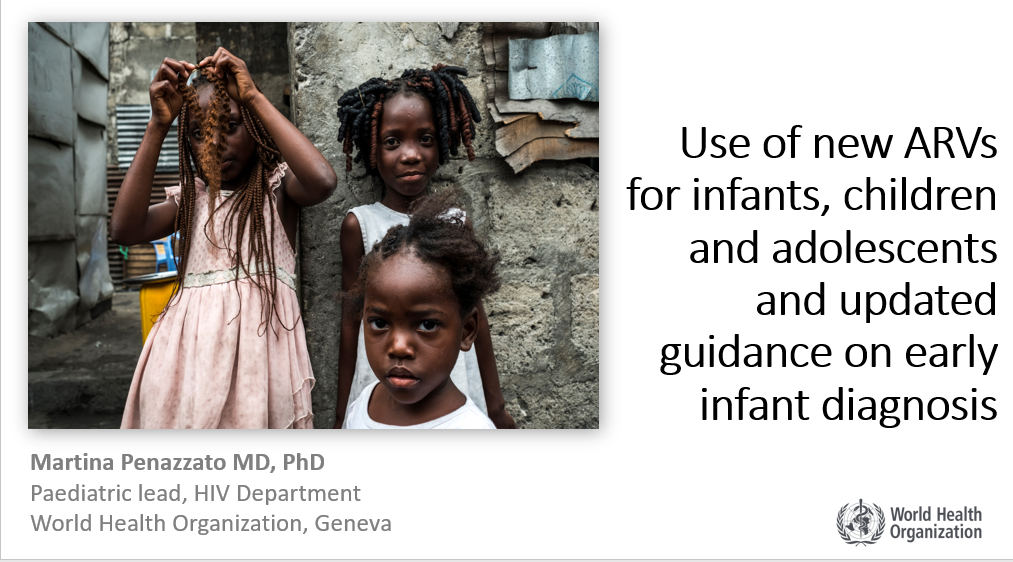AIDS 2018 Summary
On Thursday August 9, 2018, Dr. Lynne Mofenson presented selected abstracts on PMTCT, children and adolescents presented at the 10th International Workshop on HIV Pediatrics and the 22nd International AIDS Conference (AIDS 2018) in July 2018.
Approaching 2020: Scaling up key interventions for children and adolescents living with HIV
Urgent and ambitious 2020 global targets are on the horizon, yet there has been insufficient progress in paediatric and adolescent HIV to date. Scaling up HIV services for all children and adolescents is needed, in alignment with the UNAIDS super-fast-track framework. It’s time to make sure that nobody is left behind.
This series of 12 policy briefs by the Child Survival Working Group (CSWG) looks at scaling up key interventions for children and adolescents living with HIV. They present evidence, policy and monitoring considerations, implementation guidance and tools necessary to scale up 12 key interventions which have proven successful in identifying, linking and supporting children and adolescents to access and remain in quality care and treatment.
They are designed for program managers in government and civil society programs, particularly at country-level, and provide practical information and direction.
Learn more in the Foreword and download the briefs below.
-
Addressing the service delivery needs of children of key populations
-
Strategies to improve retention of mother-baby pairs in PMTCT programs
-
Providing differentiated service delivery to children and adolescents
-
Point-of-care testing as a solution for timely early infant diagnosis
-
Family-based index case testing to identify children with HIV
-
Meaningful engagement of adolescents and young people in national and local HIV programming
-
Scaling up optimal antiretroviral treatment for children: A long overdue intervention
-
Preventing and treating tuberculosis among children living with HIV
-
Providing peer support for adolescents and young people living with HIV
CSWG Policy Brief: Complementary and connected: Engaging community and faith-based organizations to deliver PMTCT and pediatric HIV services
To reach global pediatric HIV targets, efforts must extend beyond clinic doors. Community-based organisations (CBOs), faith-based organisations (FBOs) and places of worship can play a pivotal role in accelerating and expanding services. However, for their contribution to be amplified, they must be engaged as integral implementing partners in service delivery and effectively linked to the health system. A systematic approach is required to formally establish and resource these linkages, as well as embed them in district planning and coordination.
This is part of a series of 12 policy briefs by the Child Survival Working Group on scaling up key interventions for children and adolescents living with HIV. Learn more.
CSWG Policy Brief: Strategies to improve retention of mother-baby pairs in PMTCT programs
Approximately half of HIV infections among children take place during breastfeeding. While there has been success in retaining pregnant women on antiretroviral therapy (ART) during pregnancy, there has been inadequate focus on retention support to
mother-baby pairs (MBPs) during the breastfeeding period.
Literature shows that the majority of MBPs not retained in prevention of mother-to-child transmission (PMTCT) programs are due to loss to follow-up (LTFU) rather than death. These children are at higher risk of vertical acquisition of HIV compared to breastfeeding infants who remain in care. Current postpartum LTFU rates limit successful implementation of PMTCT programs in sub-Saharan Africa. Cumulative sub-Saharan Africa PMTCT LTFU rates in 2011 were estimated to range from 20-28% during antenatal care, then sharply increase to 70% at four months postpartum and reach approximately 81% six months after birth.
Given these staggering statistics, the quality and effectiveness of PMTCT services should include an assessment of the proportion of MBPs retained in care and early infant diagnosis (EID) rates.
This is part of a series of 12 policy briefs by the Child Survival Working Group on scaling up key interventions for children and adolescents living with HIV. Learn more.
Women: At the Heart of the HIV Response for Children
This publication shares the perspectives of women from all over the world, including policymakers and researchers, doctors and campaigners who are helping lead the HIV response for women and children. Their testimonies illuminate and personalize the data and the narrative in the rest of the report.
Cuba Validation: Summary of Global EMTCT Criteria and Activities, WHO (2015)
In July 2015, the IATT hosted a webinar with WHO, PAHO and the Ministry of Health of Cuba to discuss the validation process for the dual elimination of MTCT of HIV and syphilis. A total of 68 participants joined the webinar from a range of countries including China, Ethiopia, DRC, Namibia and Nigeria. Additional downloads of the webinar presentations, virtual discussion summary and Q&A transcript can be found here: Cuba Validation on EMTCT of HIV & Syphilis (Jul 2015).
Cuba Validation: Next Steps, WHO (2015)
In July 2015, the IATT hosted a webinar with WHO, PAHO and the Ministry of Health of Cuba to discuss the validation process for the dual elimination of MTCT of HIV and syphilis. A total of 68 participants joined the webinar from a range of countries including China, Ethiopia, DRC, Namibia and Nigeria. Additional downloads of the webinar presentations, virtual discussion summary and Q&A transcript can be found here: Cuba Validation on EMTCT of HIV & Syphilis (Jul 2015).
